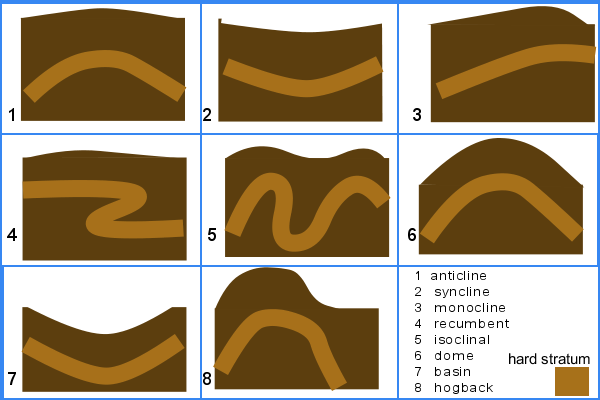Definition
Dip is the angle formed by a stratum and the horizontal.
 Main types of folds (View image in your browser to zoom in if you cannot see)
Main types of folds (View image in your browser to zoom in if you cannot see)Folding is a result of compressional forces. Compressional forces such as along convergent boundaries squeeze the crust resulting in bended or folded strata and landscape. Some major mountain belts are formed by folding.
When the sub-continent of India (continental crust) rammed the Eurasian (continental crust) Plate, the compressional and collision forces created the Himalaya mountains. Another cause of folds is magma that squeezes through the crust trying to escape.
In addition, intrusive volcanic features such as laccoliths that solidify deep in the earth’s crust can cause surrounding strata to bend.
Anticlines
Anticlines have an arch appearing strata.
Syclines
Syclines are the opposite of anticlines with a saucer shaped strata.
Anticlines and synclines are symmetrical in shape. Asymmetrical folds both have an anticline and syncline strata. Most folds are asymmetrical.
Assymetrical fold
Monoclines
Monoclines have one raised limb on one side and a gently sloping dip on the other e.g Isle of Wight, UK.
Recumbent folds
In recumbent folds, the strata is extremely folded over creating a “Z like” appearance. They’re a result of prolonged compressional forces in one direction.
Isoclinal folds
These folds have limbs that run parallel to the same direction.
Domes
Domes are formed from prolonged compressional forces along anticlines.
Basins
Basins are saucer shaped formed from prolonged compressional forces along a syncline.
Hogbacks
A Hogback is an asymmetrical fold that dip very steeply about 45o.
Reference: Fundamentals of Geomorphology, John Hugget
